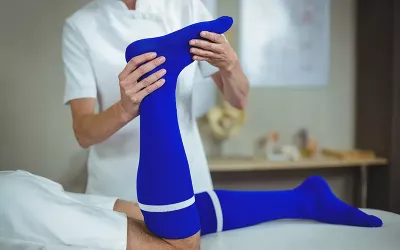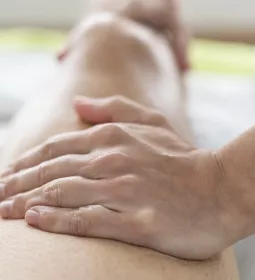Let’s bust a myth right out of the gate: Just because a client has ticklish feet does not mean they can’t enjoy a foot massage! I recall learning otherwise when I was in school, and, as a result, many clients unfortunately got almost full-body massages . . . minus the feet. Those poor feet must have been thinking, “Wait! What about me? I deserve some love too!”

The key to working with ticklish feet is to understand what makes them ticklish. I’d say this is the case for pretty much any part of the body; understand what makes it push back, then work with it respectfully and mindfully. In the end, it’s simply the nervous system’s stimulus-response mechanism at work.
What Makes Feet Ticklish
In the case of the feet’s tickle response, there are a few common reasons why it occurs:
-
There is a dense presence of sensory nerve endings in the soles of the feet that register light touch, specifically Meissner’s corpuscles.
-
Unexpected touch may result in the brain perceiving it as a surprise and potentially a threat.
-
Peripheral neuropathy, which is when nerves and nerve endings outside the central nervous system are damaged and unable to accurately register sensations.
-
Occasionally, when the client has experienced certain types of physical trauma—even in other areas of the body—the feet will mirror this trauma in parts of the feet (or the entirety of the feet) and withdraw as a defense mechanism in response to certain types of touch (like the aforementioned light or unexpected kind). I learned this from an experienced reflexologist years ago and have seen this truth in action. Note that the client might not be aware of this connection. While it isn’t our job to suss out the origins of this response, we can still meet the body with quiet recognition and reverence for whatever the experience, if indeed this is the case.
Similar to other areas of the body that may experience intense sensation (such as pain) or relentless tension, it means something is being held there. We can offer acknowledgment and reverence for whatever is causing the signal to “Back off!” It doesn’t matter that you know what the story is. What matters is that you can approach the nervous system response in a mindful and purposeful way. The body responds to external stimulus, and we have the opportunity to present a confident, caring, and reverent one.
Ways to Address Ticklish Feet
Do we skip over the feet to avoid discomfort? Sure, we can do that. Or, we can work with the client to meet them where they are, listen to the body’s physical response, honor it, and offer whatever comfort it will allow. Because I’m a big believer in communicating with the body (sometimes silently, sometimes openly depending on the client), I typically pause and say to the feet, “I recognize that you feel sensitive. If you’re willing, I’d like to work with you.”
It’s no different than any relationship where a person feels sensitive to a particular approach. You can ignore the person or you can say, “I’d like to listen to you and work with you, if you are willing.” This alone softens the barrier and creates openness that eventually can lead to trust.
It’s important, first and foremost, to know when this response will likely occur. The best way to do that is to ask the question with each new client during their initial intake interview: “Are there any parts of your body that are ticklish? If so, where?” Then, engage in a conversation to determine if the client is willing to explore ways to work with it rather than around it. This is a much better approach than stumbling upon this information mid-session!
It’s most commonly light touch that incites the tickle response.
So, easy enough—don’t use light touch!
Once the client’s willingness has been established, here are five ways to mindfully collaborate with the nervous system’s autonomic response of protection and withdrawal so our ticklish clients can still enjoy the soothing bliss of a carefully applied foot treatment.
Avoid Light Strokes Entirely
Remember, it’s most commonly light touch that incites the tickle response. So, easy enough—don’t use light touch, especially on the soles (plantar sides) of the feet. Instead, engage the tissue with slow strokes that intentionally engage the deeper tissues.
Let the Body Know You’re Coming
Think of this next suggestion as “knocking on the door” of the feet. As you arrive at the ankles, pause. Give the ankles a slight squeeze, then sustain this pressure as you move down onto the feet. Recall that surprise touch can cause a startle response even when the client doesn’t have ticklish feet. This approach works for both situations.
Engage the Top and Bottom of the Feet Simultaneously
I call this the “foot sandwich.” Start by sandwiching the anterior and posterior ankles with both hands, then glide down to encompass the entire foot. From there, you can use repeated gliding strokes proximally and distally while maintaining the squeeze.
Avoid Pointed Pressure
Instead of using fingertips or thumbs, keep strokes broad and engaged. Use broad compressions, squeezing, and wringing techniques.
Have Clients Keep Their Socks On
The feet have far less sensitivity when there is a layer of protection, such as when wearing socks. You still want to avoid light touch, unexpected touch, and pointed pressure.
Let the Client Lead the Way
I have one client who is adamant about not having their feet touched. They are completely convinced that no matter what I try, I risk getting kicked in the face. So, we laugh about it, and I honor the request. In place of massage, I begin with a pre-session foot bath (in which they dry their feet with a towel I provide specifically in their favorite color).
Sometimes remembering, honoring, and working together with our clients’ sensitivities builds a bond. Maybe they’ll eventually say, “Let’s give it a try!” Or not. At the very least, it shows you care. And the feet are not left out. There is always a way to adapt.









